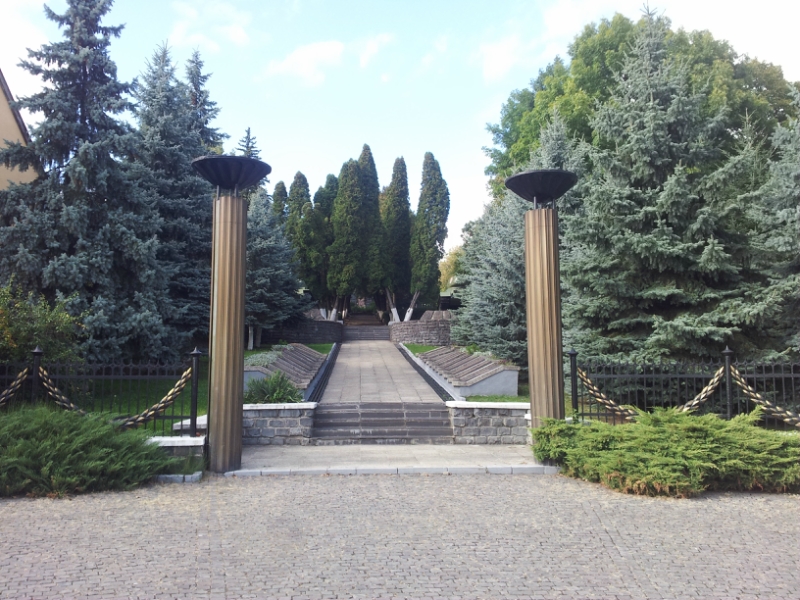Мемориал солдатам EarthCache
-
Difficulty:
-

-
Terrain:
-

Size:  (other)
(other)
Please note Use of geocaching.com services is subject to the terms and conditions
in our disclaimer.
Мемориал солдатам
Место ухоженное, красивое. Вокруг частный сектор и обычное кладбище. Плиты с именами советских воинов, два танка Т-34 и Т-70.

Ларвикит является членом семейства полевых шпатов. Название происходит от Ларвик-Фьорда в Норвегии, там где этот тип магматической породы был найден. Его иногда называют "черный лунный камень" и даже "лабрадорит", скорее всего потому, что все они относятся к минералам семейства полевых шпатов.
Наряду с лабрадором можно услышать «лабрадорит». Это не одно и то же: лабрадорит - магматическая горная порода, состоящая в основном из лабрадора и различных минералов. Цвет этой породы светло-серый, темно-серый и почти черный. Лучшие образцы лабрадорита содержат до нескольких тысяч ярких иризирующих кристаллов лабрадора на один квадратный метр породы, а размер самых крупных кристаллов достигает 100 мм. Лабрадорит – ценный декоративный и облицовочный камень. В отличие от него, лабрадор нашёл широкое применение в ювелирном деле в качестве драгоценного камня. Благодаря своим уникальным свойствам завоевал всемирную популярность.
Кроме России месторождения лабрадора есть в Канаде, Финляндии, Германии, Гренландии, Украины и на Мадагаскаре. Обычно лабрадор обрабатывают в виде кабошонов. Из прозрачных разновидностей «солнечного камня» изготавливают огранённые вставки.
Вопросы:
1. Посмотрите на структуру гранита которая ест на ступеньках. Размеры кристаллов и их цвет отличаются. Почему существуют различные размеры кристаллов в камне и какой размер самый большой вы можете увидеть там.
Необязательный:
1. Вы можете сделать несколько фотографий.
Soldiers memorial
The place is well-kept. There are memorial plates of soldiers who died in the liberation of the city. There are also two tanks on the enterence T-34 and T-70.
Larvikite is a coarse grained igneous rock that derives its name from the type-locality near Larvik in southern Norway. Its coarse grained nature, spectacular blue iridescent colour and the fact that the rock is largely unfractured lends itself to being one of the most popular used and most recognizable decorative building stones in the world. Varieties of larvikite are commonly known commercially as "Blue Pearl Granite", although almost nothing of its mineralogical composition makes it granitic. In Britain, it is often known as Publich-houseite or pub stone because it is commonly used as exterior and interior facing stone on walls and counter tops in bars. The major use of larvikite is as an exterior and interior facing stone. However, larvikite has also been fashioned for use as a gemstone and into several ornamental and functional items.
Mineralogy
Larvikite is a rock primarily comprised of medium to coarse-grained euhedral feldspar crystals. Look closely at the feldspar crystals and you may notice a blue iridescent shimmer. This phenomena is best observed on a sunny day and is known as the Schiller effect (often wrongly called Labradorescence). The play in colours is due to submicroscopic layering of plagioclase feldspar (specifically oligoclase) and alkali (potassium) feldspar in a phenomena known as anti-perthite. The layering is on a comparable scale to the wavelength of blue light and scatters this wavelength to give the crystals a blue appearance.
Other minerals that may occur in larvikite include augite (pyroxene), amphibole, biotite, quartz, nepheline (but not at the same time as quartz because they are mutually exclusive), iron-titanium oxides (e.g. ilmenite, hematite, magnetite, etc.), apatite, zircon, and/or olivine. These minerals occupy the spaces between the feldspar crystals. If you happen to be carrying a magnet, look for silver-y (often described as gun-barrel grey) milimetre-scale blobs between feldspar grains and try placing it against the building stone and see if you can feel an attraction between the magnet and the rock. Not surprisingly, the presence of magnetite makes the rock mildly magnetic.
Rock Type The wide variety of intergrown crystals with little to no apparent fabric suggests that this is an igneous rock. Igneous rocks are rocks that formed through the cooling of melted rock; lava if it is at surface or magma if it is at depth. The coarse grains found within the rock indicate that the melt cooled slowly, probably 3 to 4 kilometres below the surface of the Earth. Slow cooling is necessary for large crystals to develop (compare the crystal size in glacier ice versus ice in your freezer).
Geology
The Oslo Region is a geographic term referring to an area of about 100 000 km2, which contains sedimentary rocks of Cambrian, Ordovician, Silurian and Carboniferous age as well as sedimentary, plutonic and volcanic rocks of Permian age. The southernmost part of the Oslo Region, the Larvik plutonic complex, is made up of monzonitic rocks, mainly larvikite and closely related varieties, which occupies more than 1000 km2. The complex formed during late Carboniferous to Permian extension and continental rifting across NW Europe. During this time, the Oslo Region was the site of extensive magmatic activity. The Larvik Batholith itself is about 292-298 million years old. It has been proposed that the larvikites are derived by fractional crystallization at the base of the crust from mantle-derived alkaline basalts. When fractionation of the residual magma reached monzonitic compositions, it forced its way upward into the upper crust and crystallized under dry, reducing conditions, and without being significantly affected by the country rocks.
Question:
1. Check out the granite structure on the coordinates at stairs. The sizes of the crystals and their colors are different. Why there are different sizes of crystals in the stone and what size is the biggest crystal you can see there.
Optional:
1. If you want you can make some photos and add them to your log.
Additional Hints
(No hints available.)